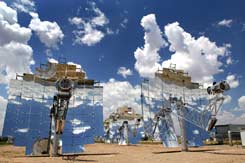Sandia National Laboratories and Stirling Energy Systems (SES) set a new solar-to-grid system conversion efficiency record by achieving a 31.25 percent net efficiency rate. The old 1984 record of 29.4 percent was toppled Jan. 31 on SES’s “Serial #3” solar dish Stirling system at Sandia’s National Solar Thermal Test Facility.
The conversion efficiency is calculated by measuring the net energy delivered to the grid and dividing it by the solar energy hitting the dish mirrors. Auxiliary loads, such as water pumps, computers and tracking motors, are accounted for in the net power measurement.
“Gaining two whole points of conversion efficiency in this type of system is phenomenal,” says Bruce Osborn, SES president and CEO. “This is a significant advancement that takes our dish engine systems well beyond the capacities of any other solar dish collectors and one step closer to commercializing an affordable system.”
Serial #3 was erected in May 2005 as part of a prototype six-dish model power plant at the Solar Thermal Test Facility that produces up to 150 kilowatts (kW) of grid-ready electrical power during the day. Each dish unit consists of 82 mirrors formed in a dish shape to focus the light to an intense beam.
The solar dish generates electricity by focusing the sun’s rays onto a receiver, which transmits the heat energy to a Stirling engine. The engine is a sealed system filled with hydrogen. As the gas heats and cools, its pressure rises and falls. The change in pressure drives the pistons inside the engine, producing mechanical power, which in turn drives a generator and makes electricity.
Lead Sandia project engineer Chuck Andraka says the first and probably most important advancement was improved optics. The Stirling dishes are made with a low iron glass with a silver backing that make them highly reflective —focusing as much as 94 percent of the incident sunlight to the engine package, where prior efforts reflected about 91 percent. The mirror facets, patented by Sandia and Paneltec Corp. of Lafayette, Colo., are highly accurate and have minimal imperfections in shape.
Both improvements allow for the loss-control aperture to be reduced to seven inches in diameter — meaning light is highly concentrated as it enters the receiver.
Other advancements to the solar dish-engine system that helped Sandia and SES beat the energy conversion record were a new, more effective radiator that also costs less to build and a new high-efficiency generator.
Osborn says that SES is working to commercialize the record-performing system and has signed power purchase agreements with two major Southern California utilities (Southern California Edison and San Diego Gas & Electric) for up to 1,750 megawatts (MW) of power, representing the world’s two largest solar power contracts. Collectively, these contracts require up to 70,000 solar dish engine units.

